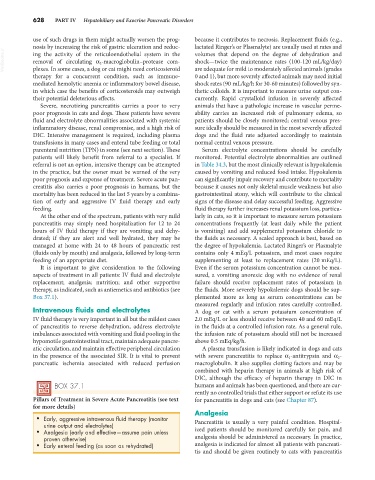Page 656 - Small Animal Internal Medicine, 6th Edition
P. 656
628 PART IV Hepatobiliary and Exocrine Pancreatic Disorders
use of such drugs in them might actually worsen the prog- because it contributes to necrosis. Replacement fluids (e.g.,
nosis by increasing the risk of gastric ulceration and reduc- lactated Ringer’s or Plasmalyte) are usually used at rates and
VetBooks.ir ing the activity of the reticuloendothelial system in the volumes that depend on the degree of dehydration and
shock—twice the maintenance rates (100-120 mL/kg/day)
removal of circulating α 2 -macroglobulin–protease com-
plexes. In some cases, a dog or cat might need corticosteroid
0 and 1), but more severely affected animals may need initial
therapy for a concurrent condition, such as immune- are adequate for mild to moderately affected animals (grades
mediated hemolytic anemia or inflammatory bowel disease, shock rates (90 mL/kg/h for 30-60 minutes) followed by syn-
in which case the benefits of corticosteroids may outweigh thetic colloids. It is important to measure urine output con-
their potential deleterious effects. currently. Rapid crystalloid infusion in severely affected
Severe, necrotizing pancreatitis carries a poor to very animals that have a pathologic increase in vascular perme-
poor prognosis in cats and dogs. These patients have severe ability carries an increased risk of pulmonary edema, so
fluid and electrolyte abnormalities associated with systemic patients should be closely monitored; central venous pres-
inflammatory disease, renal compromise, and a high risk of sure ideally should be measured in the most severely affected
DIC. Intensive management is required, including plasma dogs and the fluid rate adjusted accordingly to maintain
transfusions in many cases and enteral tube feeding or total normal central venous pressure.
parenteral nutrition (TPN) in some (see next section). These Serum electrolyte concentrations should be carefully
patients will likely benefit from referral to a specialist. If monitored. Potential electrolyte abnormalities are outlined
referral is not an option, intensive therapy can be attempted in Table 34.3, but the most clinically relevant is hypokalemia
in the practice, but the owner must be warned of the very caused by vomiting and reduced food intake. Hypokalemia
poor prognosis and expense of treatment. Severe acute pan- can significantly impair recovery and contribute to mortality
creatitis also carries a poor prognosis in humans, but the because it causes not only skeletal muscle weakness but also
mortality has been reduced in the last 5 years by a combina- gastrointestinal atony, which will contribute to the clinical
tion of early and aggressive IV fluid therapy and early signs of the disease and delay successful feeding. Aggressive
feeding. fluid therapy further increases renal potassium loss, particu-
At the other end of the spectrum, patients with very mild larly in cats, so it is important to measure serum potassium
pancreatitis may simply need hospitalization for 12 to 24 concentrations frequently (at least daily while the patient
hours of IV fluid therapy if they are vomiting and dehy- is vomiting) and add supplemental potassium chloride to
drated; if they are alert and well hydrated, they may be the fluids as necessary. A scaled approach is best, based on
managed at home with 24 to 48 hours of pancreatic rest the degree of hypokalemia. Lactated Ringer’s or Plasmalyte
(fluids only by mouth) and analgesia, followed by long-term contains only 4 mEq/L potassium, and most cases require
feeding of an appropriate diet. supplementing at least to replacement rates (20 mEq/L).
It is important to give consideration to the following Even if the serum potassium concentration cannot be mea-
aspects of treatment in all patients: IV fluid and electrolyte sured, a vomiting anorexic dog with no evidence of renal
replacement; analgesia; nutrition; and other supportive failure should receive replacement rates of potassium in
therapy, as indicated, such as antiemetics and antibiotics (see the fluids. More severely hypokalemic dogs should be sup-
Box 37.1). plemented more as long as serum concentrations can be
measured regularly and infusion rates carefully controlled.
Intravenous fluids and electrolytes A dog or cat with a serum potassium concentration of
IV fluid therapy is very important in all but the mildest cases 2.0 mEq/L or less should receive between 40 and 60 mEq/L
of pancreatitis to reverse dehydration, address electrolyte in the fluids at a controlled infusion rate. As a general rule,
imbalances associated with vomiting and fluid pooling in the the infusion rate of potassium should still not be increased
hypomotile gastrointestinal tract, maintain adequate pancre- above 0.5 mEq/kg/h.
atic circulation, and maintain effective peripheral circulation A plasma transfusion is likely indicated in dogs and cats
in the presence of the associated SIR. It is vital to prevent with severe pancreatitis to replace α 1 -antitrypsin and α 2 -
pancreatic ischemia associated with reduced perfusion macroglobulin. It also supplies clotting factors and may be
combined with heparin therapy in animals at high risk of
DIC, although the efficacy of heparin therapy in DIC in
BOX 37.1 humans and animals has been questioned, and there are cur-
rently no controlled trials that either support or refute its use
Pillars of Treatment in Severe Acute Pancreatitis (see text for pancreatitis in dogs and cats (see Chapter 87).
for more details)
Analgesia
• Early, aggressive intravenous fluid therapy (monitor
urine output and electrolytes) Pancreatitis is usually a very painful condition. Hospital-
• Analgesia (early and effective—assume pain unless ized patients should be monitored carefully for pain, and
proven otherwise) analgesia should be administered as necessary. In practice,
• Early enteral feeding (as soon as rehydrated) analgesia is indicated for almost all patients with pancreati-
tis and should be given routinely to cats with pancreatitis

